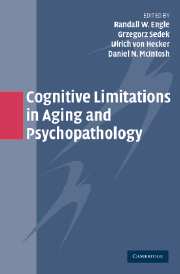Book contents
- Frontmatter
- Contents
- List of Contributors
- Preface
- Acknowledgments
- 1 Cognitive Limitations in Aging and Psychopathology: An Introduction and a Brief Tutorial to Research Methods
- SECTION I WORKING MEMORY AND COGNITIVE FUNCTIONS
- SECTION II AGING AND PSYCHOPATHOLOGY OF COGNITIVE CONTROL
- 5 The Aging of Cognitive Control: Studies of Conflict Processing, Goal Neglect, and Error Monitoring
- 6 Cognitive Control and Schizophrenia: Psychological and Neural Mechanisms
- 7 Aging and Varieties of Cognitive Control: A Review of Meta-Analyses on Resistance to Interference, Coordination, and Task Switching, and an Experimental Exploration of Age-Sensitivity in the Newly Identified Process of Focus Switching
- 8 An Ecological Approach to Studying Aging and Dual-Task Performance
- 9 Cognitive Performance After Preexposure to Uncontrollability and in a Depressive State: Going with a Simpler “Plan B”
- SECTION III ATTENTION, INHIBITION, AND REASONING PROCESSES
- Name Index
- Subject Index
- References
7 - Aging and Varieties of Cognitive Control: A Review of Meta-Analyses on Resistance to Interference, Coordination, and Task Switching, and an Experimental Exploration of Age-Sensitivity in the Newly Identified Process of Focus Switching
Published online by Cambridge University Press: 20 May 2010
- Frontmatter
- Contents
- List of Contributors
- Preface
- Acknowledgments
- 1 Cognitive Limitations in Aging and Psychopathology: An Introduction and a Brief Tutorial to Research Methods
- SECTION I WORKING MEMORY AND COGNITIVE FUNCTIONS
- SECTION II AGING AND PSYCHOPATHOLOGY OF COGNITIVE CONTROL
- 5 The Aging of Cognitive Control: Studies of Conflict Processing, Goal Neglect, and Error Monitoring
- 6 Cognitive Control and Schizophrenia: Psychological and Neural Mechanisms
- 7 Aging and Varieties of Cognitive Control: A Review of Meta-Analyses on Resistance to Interference, Coordination, and Task Switching, and an Experimental Exploration of Age-Sensitivity in the Newly Identified Process of Focus Switching
- 8 An Ecological Approach to Studying Aging and Dual-Task Performance
- 9 Cognitive Performance After Preexposure to Uncontrollability and in a Depressive State: Going with a Simpler “Plan B”
- SECTION III ATTENTION, INHIBITION, AND REASONING PROCESSES
- Name Index
- Subject Index
- References
Summary
Adult age differences favoring the young have been demonstrated in a wide variety of tasks of fluid intelligence. Such age-sensitive tasks include (among many others): simple reaction times and choice reaction times, working memory tasks, tests of episodic memory, tests of spatial and reasoning abilities, mental rotation, and visual search performance (for exhaustive reviews, see e.g., Kausler, 1991; Salthouse, 1985, 1991; note that performance on other tasks, such as vocabulary measures, does not show negative age effects; e.g., Salthouse, 1991; Verhaeghen, 2003). The challenge for cognitive aging as a field is to identify the basic changes responsible for these declines. Given that the deficits are so widespread across the cognitive system, it is reasonable to assume that a limited number of basic mechanisms may explain a large number of the deficits.
It is no surprise, then, that much of the research on cognitive aging has centered on the investigation of the age effects of so-called cognitive primitives, that is, variables that influence the cognitive system without themselves being reducible to other psychological constructs. For a long time, the dominant theory in the field pertained to the influence of processing speed (Salthouse, 1991, 1996; for a meta-analysis, see Verhaeghen & Salthouse, 1997). This hypothesis views cognition as being driven by a processing rate and asserts that this rate is slower in older adults than in younger adults. More recently, the attention of the field has been drawn toward more process-specific accounts.
- Type
- Chapter
- Information
- Cognitive Limitations in Aging and Psychopathology , pp. 160 - 189Publisher: Cambridge University PressPrint publication year: 2005
References
- 22
- Cited by



